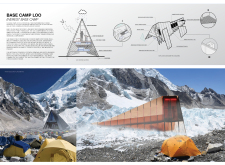5 key facts about this project
The Base Camp Loo is designed to tackle waste management challenges at Everest Base Camp, a key location for climbers. It serves as a toilet facility while emphasizing functionality and environmental responsibility. The project incorporates a thoughtful design that balances usability with the harsh conditions found in this mountainous landscape.
Design Concept
The structure features a triangular shape, which is effective and stable for the uneven terrain. The raised toilet includes a ramp for easier access, ensuring that all users can enter comfortably. Below the toilet, there is a cave-like area that offers a familiar shelter type, providing protection against bad weather while fulfilling its primary function.
Materials and Structure
A fixed timber framework forms the basis of the Base Camp Loo, giving it the necessary strength while keeping the overall weight manageable. This frame is covered with recyclable polycarbonate plastic panels, which enhance durability against strong winds and rain. These material choices allow for easy transport, enabling the components to be assembled and disassembled as the situation requires.
Waste Management System
Inside the shelter, a shelf accommodates waste and water units. These units are designed to be connected to the ceiling, allowing for easy removal when they reach capacity. This feature improves the efficiency of waste collection, which is particularly important in such extreme weather. Climbers can feel assured that waste is managed properly and safely stored until it can be processed.
Environmental Integration
The design allows for interaction with the surrounding landscape, as openings are placed to provide views of the valleys. This connection to nature contributes positively to the user experience. The Base Camp Loo is an effort to combine practical needs with the beauty of the surroundings. Comfort features, such as privacy shields and a functional handrail, enhance usability. Attention to detail in this project ensures it meets the practical requirements of its users while fitting within the natural environment.



















































